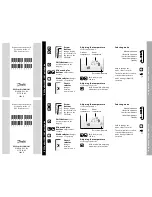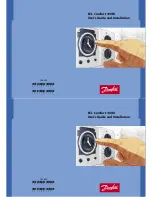
IOM-HP-S-DIFF
4
c. Lubricate adjusting screw (6) threads.
Carefully re in stall the adjusting screw (6)
up into the spring cham ber (2) by ro tat ing
the ad just ing screw (6) CW until top of
adjusting screw (6) protrudes from top of
spring chamber (2).
NOTE:
Care should
be taken when hold ing and ro tat ing the
ad just ing screw (6) so the quad ring (31)
and back up ring (32) are not in ad vert ent ly
nicked or torn.
Grasp top of ad just ing
screw (6) and turn CCW until ro ta tion
stops
(see CAUTION C)
. See Fig ure 1.
d. Loosely install lock nut (7) and closing cap
(28).
7. In
spect pressure plate (3) for defects due to
over-pres sur iza tion. Replace if de fec tive.
8. Clean all parts to be re-used according to
owner's procedures.
9. Place first o-ring (30) on body (1) and lu bri cate
with a lightweight multi-purpose grease.
Po si tion body spacer (24) on body with match
marks aligned. Place pusher plate (11) on body
spac er (24) and check for ver ti cal move ment.
NOTE:
The vertical move ment should be free
and unobstructed as the push er plate (11) is
pushed down and the lower piston spring (17)
contracts and ex pands. If move ment is not
free, go to Sub sec tion C following to inspect
the inner trim parts.
10. Place second o-ring (30) on body spacer (24)
and lubricate with lightweight multi-purpose
grease. Po si tion diaphragm (12) on body
spac er (24) in side of o-ring (30).
11. Visually center the pressure plate (3) on
di a phragm (12). Place range spring (14) onto
re tain er hub of pressure plate (3).
12. Place multi-purpose, high temperature grease
into depression of spring button (4) where
adjusting screw (6) bears. Set spring but ton (4)
onto range spring (14); ensure spring button
(4) is laying flat.
13. Using "NEW" studs (34,35) and nuts (9)
(see
CAUTION D)
, thread a nut onto each stud
approximately 1.25" (32 mm). Drop the studs
(34,35) with nuts (9) through the holes in
spring chamber (2). (This will assist in keep ing
the spring chamber (2) centered on body
(1) and prevent parts from moving dur ing re-
assembly).
Using the "match marks" made in Step 3 as a
guide, replace spring chamber (2) onto body
spacer (24). Thread on lower nuts (9) and
tighten by hand. Adjust length of studs (34,35)
by using the top nut (9) so that there are at least
3 to 4 threads protruding from the lower nut.
Torque body flange hardware (9,23,34,35)
using small increments in a 180° al ter nat ing
pattern until flange mating sur fac es of body
(1), body spacer (24) and spring chamber
(2) are metal to metal. This creates a "fixed
compression" on the di a phragm (12) and
o-ring (30) seals. Rec om mend ed torque
val ues are listed in Table 1.
TABLE 1
Body Size
in. (DN)
Item
No.
Thread
Size
Torque Values
Ft-lbs (N-m)
1/2"-1" (15-25)
9,23,34
3/8"-24
35-40
(47-54)
1-1/2" (40)
9,23,34,35
7/16"-20
55-60
(75-81)
14. With locknut (7) tight against closing cap
(28), turn closing cap (28) CW until tension is
ap plied to range spring (14).
15. Proceed to Section D. for bench test.
C. Trim Replacement:
NOTE:
Do not release tension on range spring
(14). (Only necessary when removing spring
cham ber). The range spring (14) ten sion
keeps pusher plate (11) in alignment and
as sures proper fit upon replacement of trim.
1. Install body (1) in a vise with the body cap (5)
on top and spring chamber (2) downwards.
2. Loosen and remove body cap (5).
NOTE:
Pis ton spring (17) may stick in body cap (5)
when removing.
3. Remove piston spring (17), piston (15) and
cylinder (16). Inspect parts for ex ces sive
wear, espe cially at piston (15) seat surface.
En sure there are no nicks or foreign particles
em bed ded in the piston (15) TFE seat.
Re place piston w/ TFE seat (15) if necessary.
In spect the back up ring (27) and quad ring (26)
on piston (15). Re place rings if worn, nicked,
or de pressed.
4. Remove body cap O-ring (25). Clean
con tact ing surfaces of body (1) and body cap
(5). Be care ful not to scratch either surface.
In spect inside sur face of the body cap for
scratch es or nicks. These could result in
leak age past the quad ring (26) and backup
ring (27). If worn or scratched replace body
cap (5).




























